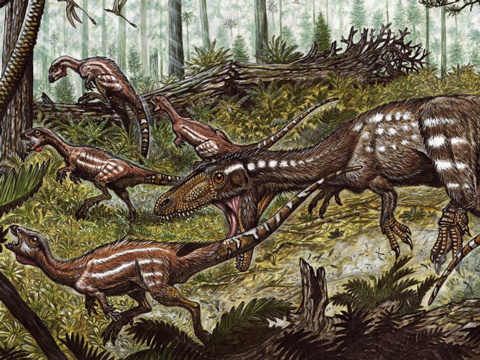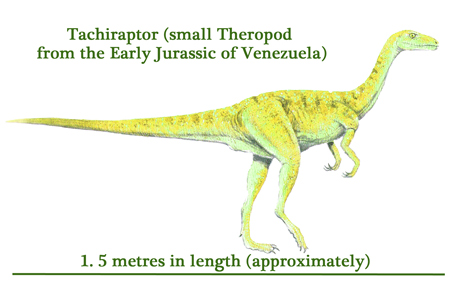Tachiraptor admirabilis – Tracing the Origins of the Big Theropods
Venezuelan dinosaurs must be a bit like buses, you wait for years for one to come along and then two arrive almost simultaneously. Back in August of this year, we reported on the discovery of Venezuela’s first ever dinosaur, a small, plant-eater from the very Early Jurassic. This dinosaur was named Laquintasaura venezuelae and it was the first dinosaur named from the north of South America. Two months later and a second paper about a new Venezuelan dinosaur, this time a meat-eater, is about to be published. Say hello to Tachiraptor, a bipedal, fast-running carnivore that may very well have been a predator Laquintasaura.
An Artists Impression of Tachiraptor Attacking Laquintasaura
Picture credit: Maurílio Oliveira
The illustration above shows the fearsome, newly described theropod Tachiraptor attacking a small flock of primitive, ornithopod dinosaurs (Laquintasaura), whilst a couple of alarmed rhamphorhynchid pterosaurs take flight.
To read more about Laquintasaura: Laquintasaura – What Does it All Mean?
Tachiraptor admirabilis
The artist has chosen to illustrate both the dinosaurs in the picture as feathered creatures. During the Early Jurassic, around 200 million years ago, approximately the time that both Tachiraptor and Laquintasaura lived, Venezuela was close to the equator. The sandstone deposits in which the fossils were found indicate a flood plain environment. This flood plain was surrounded by harsh, inhospitable deserts that probably did not support much vertebrate life. Day temperatures would have been high, but just like many desert areas close to the equator today, at night, temperatures would have plummeted. Relatively small animals like Tachiraptor and the even smaller Laquintasaura may have sported a coat of insulating feathers to help keep them warm.
A recent dinosaur discovery from Siberia (Kulindadromeus), suggests that many early types of dinosaur may have been feathered, although no fossil evidence for feathers in both Laquintasaura and Tachiraptor has been found (as far as we at Everything Dinosaur know), it seems reasonable at this point to depict these Early Jurassic members of the Dinosauria as feathered.
To read more about the discovery of Kulindadromeus: Information on Early Feathered Dinosaurs.
The Dinosaur Biota of Venezuela
If Laquintasaura has been described as being about the size of a red fox (Vulpes vulpes), then to keep the canine motif, the predatory Tachiraptor may have been around the size of a grey wolf (Canis lupis), with a total length of 1.5 metres. The size estimate is based on the two fossil bones ascribed to this genus discovered so far. The fossils represent lower leg bones from two individuals, the research team responsible for the excavation and study of this new theropod (Universidade de São Paulo), Brazil found the bones back in 2013 in the same cutting between the towns of La Grita and Seboruco where the fossils of Laquintasaura had been found.
Tachiraptor admirabilis honours the Venezuelan state of Táchira, the species name is in commemoration of the 1813 campaign led by Simón Bolívar to form a republic (known in Spanish as the Campaña Admirable – admirable campaign).
Tachiraptor – The Name Means “Robber of Táchira”
Picture credit: Everything Dinosaur
Limb Bone Fossils
Dr Max Cardoso Langer, of the palaeontology department of São Paulo University, one of the scientists involved with this study, explained that the fossil material consisted of a tibia and a second lower leg bone that was fragmented. However, the locality and morphology of these scrappy fossils gave the research team the confidence to assign a new genus. Although the exact taxonomic affinity within the Theropoda could not be established as the fossils date from the Hettangian faunal stage, it was most likely a basal theropod.
A spokesperson from Everything Dinosaur stated:
“Very little is known about the dinosaurs that lived in the very Early Jurassic. When Tachiraptor and Laquintasaura roamed Venezuela some 200 million years ago, the world was recovering from a mass extinction event. The fossils of these two dinosaurs will help palaeontologists to understand better the implications for the Dinosauria after the Triassic/Jurassic mass extinction.”








Leave A Comment